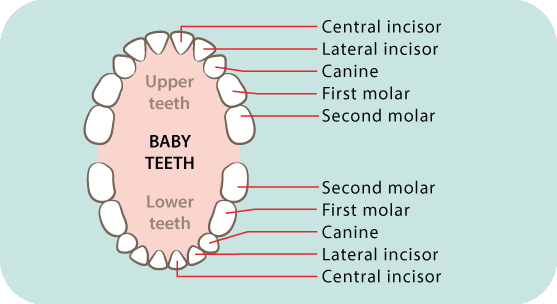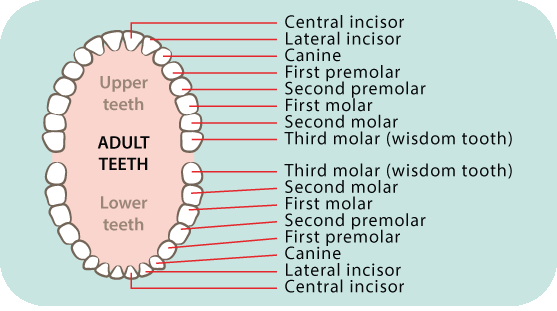How Many Baby Teeth Do We Have to Lose
Teeth development
Most children have a full set of 20 baby teeth by the time they're 3 years old.
Children usually start losing their baby teeth from around 6 years of age. From 6-12 years, children have a mixture of adult and baby teeth. The baby molars are replaced around 12 years of age. By about 12, most children have all their adult teeth except for the third molars (wisdom teeth). There are 32 adult teeth.
If your child's baby teeth came late, the adult teeth will probably be late too. If you're concerned about your child's teeth development, see your dentist.
When adult teeth are coming through
Your child might find chewing is more difficult when teeth are loose or missing, but your child still needs to eat healthy foods.
It's important to keep up your child's teeth-brushing routine, taking extra care around the loose teeth or sensitive areas. But let loose teeth fall out on their own. If you try to pull out a tooth before it's ready to fall out, it can injure the gums and nearby teeth, and also cause pain and infection.
Sometimes an adult tooth will come through before the baby tooth has fallen out. If the baby tooth hasn't fallen out within 2-3 months, see your dentist.


Dental care: keeping your child's teeth clean
Brush your child's teeth twice a day – morning and night.
Until your child turns 6, use a pea-sized amount of low-fluoride toothpaste on a child-size toothbrush. Once your child is 6 years old, you can use regular adult fluoride toothpaste.
By the time your child reaches school, they might be starting to clean their own teeth. It's still a good idea for you to either start or finish the cleaning process. Your child needs your supervision and help until they're at least 8 years old.
Your child should regularly floss any teeth that touch each other.
You can also encourage your child to rinse their mouth with water after lunch and snacks. This will help to wash away any leftover food.
Losing your teeth can be an exciting but anxious time. You can help your child feel better about it by celebrating each time a tooth falls out.
The best way to brush your child's teeth
You might like to try the following routine when brushing your child's teeth:
- Stand or sit behind your child so your child feels secure. Brushing teeth in front of a mirror is good too, because it lets you see your child's mouth.
- Cup your child's chin in your hands with their head resting against your body.
- Angle the bristles of the toothbrush towards the gum. Move the brush in gentle circles to clean the outer and inner sides of the teeth and gums.
- Brush back and forth on the chewing surfaces of the teeth.
- Gently brush your child's tongue.
- Brush for around 2 minutes.
- After brushing, encourage your child to spit out toothpaste, not swallow it. There's no need to rinse after brushing because the fluoride toothpaste left behind protects your child's teeth.
If you're using an electric toothbrush, avoid moving the brush in circles. Keep your hand still, and guide the brush across your child's teeth and gums.
Teeth cleaning alone isn't a guarantee against tooth decay. Diet is also important. Avoid giving your child sugary foods and sugary drinks like fruit juice, soft drink and flavoured milk.
Toothbrushes
Your child needs a child's toothbrush that has soft bristles of different heights. This kind of toothbrush will clean your child's teeth and gums properly.
Tokeep the toothbrush clean, your child should rinse it with tap water when they've finished cleaning their teeth and gums. Store the toothbrush upright in an open container to allow it to air-dry.
You should replace toothbrushes every 3-4 months, or when the bristles get worn or frayed.
Toothpaste and fluoride
Your child can use regular adult fluoride toothpaste once they turn 6.
Fluoride is a safe mineral that helps keep teeth strong and prevent tooth decay.
Mosttap water in Australia has added fluoride.
Fluoride works best when you get it in very small amounts throughout the day in fluoridated tap water, foods and drinks containing fluoride, and fluoride toothpaste. For children who are at high risk of developing tooth decay, dentists might also prescribe gels and pastes with extra fluoride.
Dental sealants
Your dentist might recommend dental sealants for your school-age child.
Dental sealants are thin, plastic coatings that bond to the chewing surfaces of teeth (where most cavities in children are found). These sealants stop plaque build-up in the grooves of teeth and help prevent tooth decay. Applying the sealants is usually simple and quick, with no pain and very little discomfort for your child.
Sealants don't stay on your child's teeth forever. Your dentist will check them regularly. They might sometimes need fixing or reapplying.
If you're interested in dental sealants for your child, speak to your dentist.
Visiting the dentist
It's important for your child to have regular dental check-ups. Your dentist will tell you how often your child needs a check-up. Dentists usually recommend every 6-12 months.
Your child might also see other oral health professionals, depending on your child's needs. These include dental therapists, dental hygienists, oral health therapists or specialist dentists like paediatric dentists or orthodontists.
Dental health care in Australia
Dental care for children is often free in thepublic dental system, up to a certain age. For details of public dental providers, see your state or territory's health department website.
There are private dental clinics all over Australia. You'll have to pay for your appointments, but people with private health insurance might get some money back from their private health fund.
If you're eligible, the Australian Government's Child Dental Benefits Schedule covers basic dental services for children aged 2-17 years at most private and public dental clinics.
How Many Baby Teeth Do We Have to Lose
Source: https://raisingchildren.net.au/school-age/health-daily-care/dental-care/dental-care
0 Response to "How Many Baby Teeth Do We Have to Lose"
Post a Comment